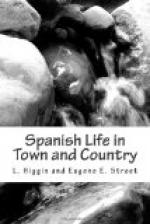Perhaps born of this necessity of making acquaintance by fair means or foul comes the custom, which appears to savour of such grossly bad manners to us, of a man making audible remarks on the appearance of a girl he has never seen before as she passes him in the street. Ay! que buenos ojos! Que bonita eres! Que gracia tienes! and the like. Far from giving offence, the fair one goes on her way, perhaps vouchsafing one glance from those lovely eyes of hers, with only a sense that her charms have received their due tribute—not much elated, perhaps, but certainly by no means offended; nor, indeed, was offence intended. The fixed stare, which to us would mean mere ill-bred ignorance, is only another ordinary tribute to the passing fair one from the other sex.
Marriage customs have changed much in the last few decades, and even civil marriages are now not wholly unknown. In old days, if the ceremony was performed in church, the bride and all the ladies must be attired in black, for which reason the fashionable world established marriages in the house, where more brilliant costumes might be displayed. These generally take place in the evening, and the newly married couple do not leave the house, unless the new home happens to be close by. In any case, honeymoon tours are, or were, unusual. The velada is the ceremony in church, which must take place before the first child is born, to legalise the marriage, but it does not necessarily immediately follow the other ceremony. At it the ring is given. When the two ceremonies take place at the same time it must be in the morning, because the bride and bridegroom partake of the Holy Sacrament fasting. From the description of a boda in Galicia, in one of Pardo Bazan’s novels, it would seem that the bride there wears white, even at the church. The wedding is a portentous affair, lasting all day from early morning, and the bride and bridegroom remain in the house. Fernan Caballero devotes some pages in Clemencia to showing how preferable is the Spanish custom of “remaining among friends” to that of the newly married couple, as she says, “exposing themselves to the jeers of postilions and stable-boys.” Yet the English custom is in fact gaining ground, even in conservative Spain.




